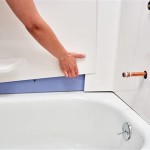The Essential Aspects of Bathtub Size
When it comes to selecting a bathtub, size is a critical consideration that impacts both comfort and functionality. Here are some essential aspects to keep in mind when determining the ideal size of a bathtub:
Length: The length of the bathtub determines how much legroom you have while soaking. A standard bathtub length ranges from 54 to 60 inches, but you can find longer options for a more spacious experience. If you're taller, consider a bathtub that is 60 inches or longer.
Width: The width of the bathtub provides the necessary shoulder room. Standard bathtub widths vary from 28 to 32 inches, but wider options are available to accommodate a more comfortable soak. For a more luxurious and spa-like experience, opt for a bathtub that is at least 30 inches wide.
Depth: The depth of the bathtub influences the level of water immersion. A deeper bathtub allows for a more enveloping and relaxing soak. Standard bathtub depths range from 14 to 18 inches, with deeper options reaching 24 inches or more. If you prefer a deeper soak, consider a bathtub with a depth of at least 20 inches.
Shape: The shape of the bathtub can impact the available space and comfort. Rectangular bathtubs offer a traditional and versatile option, while oval and round bathtubs provide a more ergonomic and comfortable soak. Freestanding bathtubs offer a modern and visually striking aesthetic, but require additional space.
Space Considerations: Before purchasing a bathtub, carefully measure the available space in your bathroom. Allow for adequate clearance around the bathtub for easy access and movement. Standard bathtubs require a clearance of at least 12 inches on all sides. Consider the size of your bathroom accessories, such as faucets and shelves, when determining the necessary clearance.
Remember that the ideal bathtub size depends on individual preferences and bathroom size. By considering these essential aspects, you can select a bathtub that meets your needs and provides the ultimate relaxation and comfort.

Standard Bathtub Sizes 2024 Guide Modernize

Best 25 Standard Tub Size Ideas Sizes Bathtub

Standard Bathtub Sizes Reference Guide To Common Tubs Tub Dimensions

What Size Is A Small Bath Ideal Baths For Bathrooms

Bathtub Sizes Standard Tub Size Guide

Bathtub Dimensions In Feet All You Need To Know

Standard Bath Size Length Width Dimensions

Universal Tubs Imperial 7 Ft Acrylic Center Drain Rectangular Drop In Non Whirlpool Bathtub White Hd4384vs The Home Depot

Bathtub Dimensions In Feet All You Need To Know

Reach 1500mm Drop In Acrylic Bathtub White Kohler








